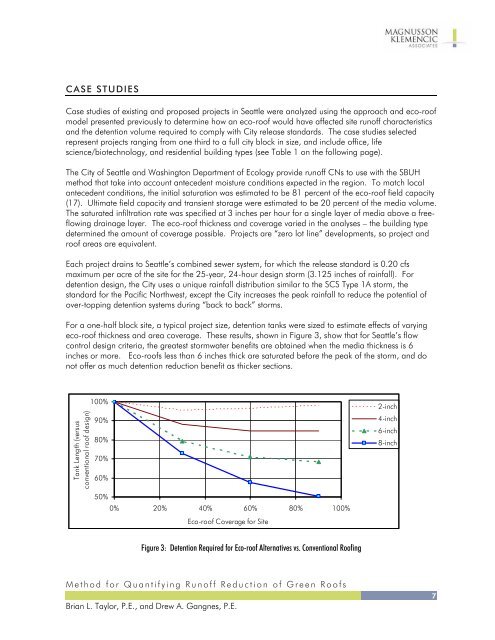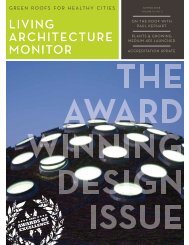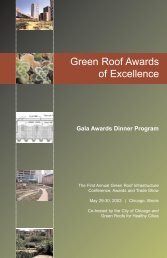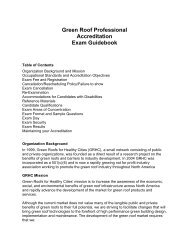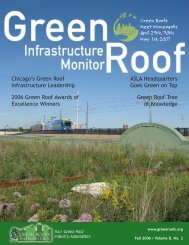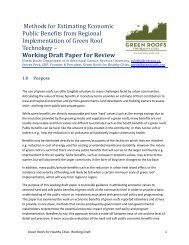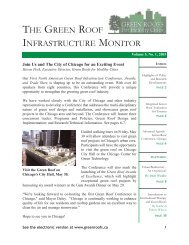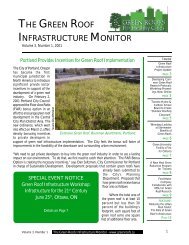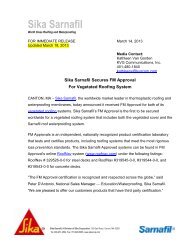Brian L. Taylor, P.E., and Drew A. Gangnes, P.E. - Green Roofs for ...
Brian L. Taylor, P.E., and Drew A. Gangnes, P.E. - Green Roofs for ...
Brian L. Taylor, P.E., and Drew A. Gangnes, P.E. - Green Roofs for ...
- No tags were found...
You also want an ePaper? Increase the reach of your titles
YUMPU automatically turns print PDFs into web optimized ePapers that Google loves.
CASE STUDIESCase studies of existing <strong>and</strong> proposed projects in Seattle were analyzed using the approach <strong>and</strong> eco-roofmodel presented previously to determine how an eco-roof would have affected site runoff characteristics<strong>and</strong> the detention volume required to comply with City release st<strong>and</strong>ards. The case studies selectedrepresent projects ranging from one third to a full city block in size, <strong>and</strong> include office, lifescience/biotechnology, <strong>and</strong> residential building types (see Table 1 on the following page).The City of Seattle <strong>and</strong> Washington Department of Ecology provide runoff CNs to use with the SBUHmethod that take into account antecedent moisture conditions expected in the region. To match localantecedent conditions, the initial saturation was estimated to be 81 percent of the eco-roof field capacity(17). Ultimate field capacity <strong>and</strong> transient storage were estimated to be 20 percent of the media volume.The saturated infiltration rate was specified at 3 inches per hour <strong>for</strong> a single layer of media above a freeflowingdrainage layer. The eco-roof thickness <strong>and</strong> coverage varied in the analyses – the building typedetermined the amount of coverage possible. Projects are “zero lot line” developments, so project <strong>and</strong>roof areas are equivalent.Each project drains to Seattle’s combined sewer system, <strong>for</strong> which the release st<strong>and</strong>ard is 0.20 cfsmaximum per acre of the site <strong>for</strong> the 25-year, 24-hour design storm (3.125 inches of rainfall). Fordetention design, the City uses a unique rainfall distribution similar to the SCS Type 1A storm, thest<strong>and</strong>ard <strong>for</strong> the Pacific Northwest, except the City increases the peak rainfall to reduce the potential ofover-topping detention systems during “back to back” storms.For a one-half block site, a typical project size, detention tanks were sized to estimate effects of varyingeco-roof thickness <strong>and</strong> area coverage. These results, shown in Figure 3, show that <strong>for</strong> Seattle’s flowcontrol design criteria, the greatest stormwater benefits are obtained when the media thickness is 6inches or more. Eco-roofs less than 6 inches thick are saturated be<strong>for</strong>e the peak of the storm, <strong>and</strong> donot offer as much detention reduction benefit as thicker sections.Tank Length (versusconventional roof design)100%90%80%70%60%2-inch4-inch6-inch8-inch50%0% 20% 40% 60% 80% 100%Eco-roof Coverage <strong>for</strong> SiteFigure 3: Detention Required <strong>for</strong> Eco-roof Alternatives vs. Conventional RoofingMethod <strong>for</strong> Quantifying Runoff Reduction of <strong>Green</strong> <strong>Roofs</strong><strong>Brian</strong> L. <strong>Taylor</strong>, P.E., <strong>and</strong> <strong>Drew</strong> A. <strong>Gangnes</strong>, P.E.7


